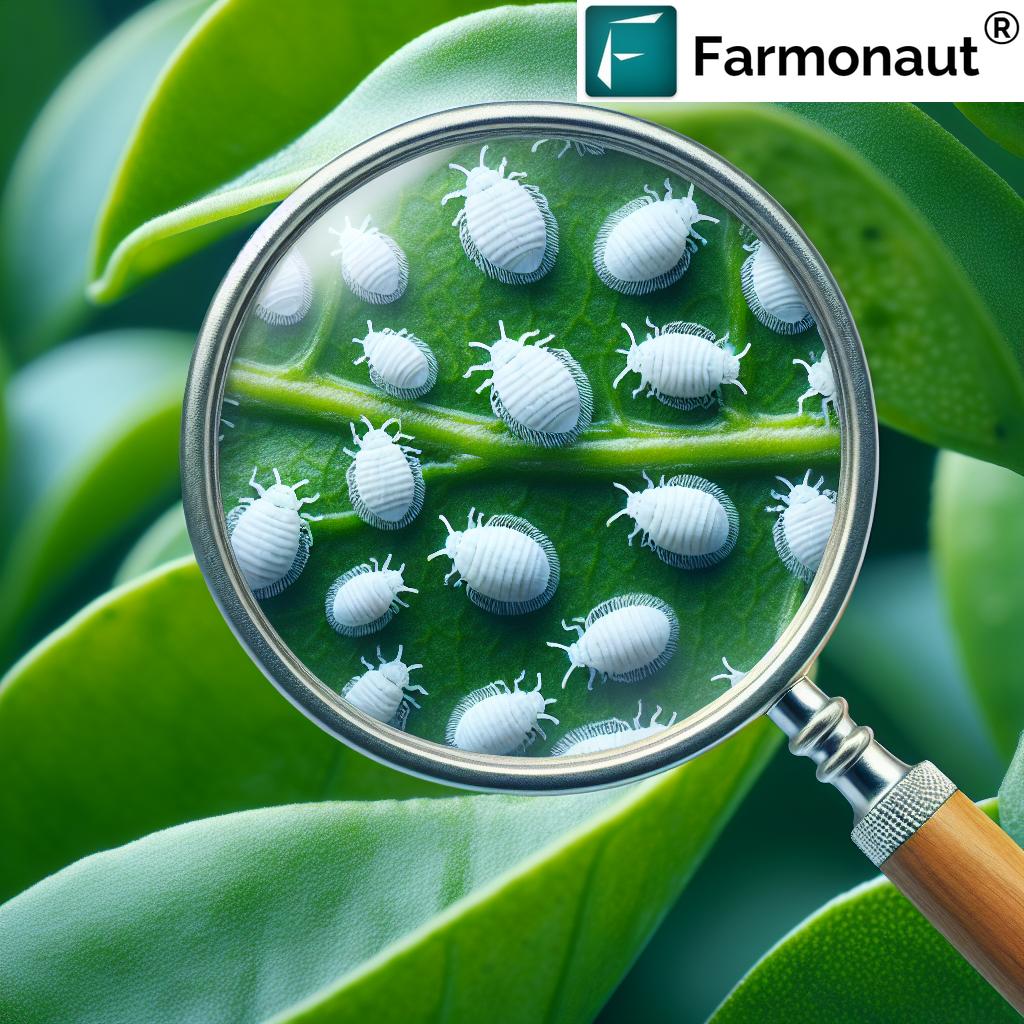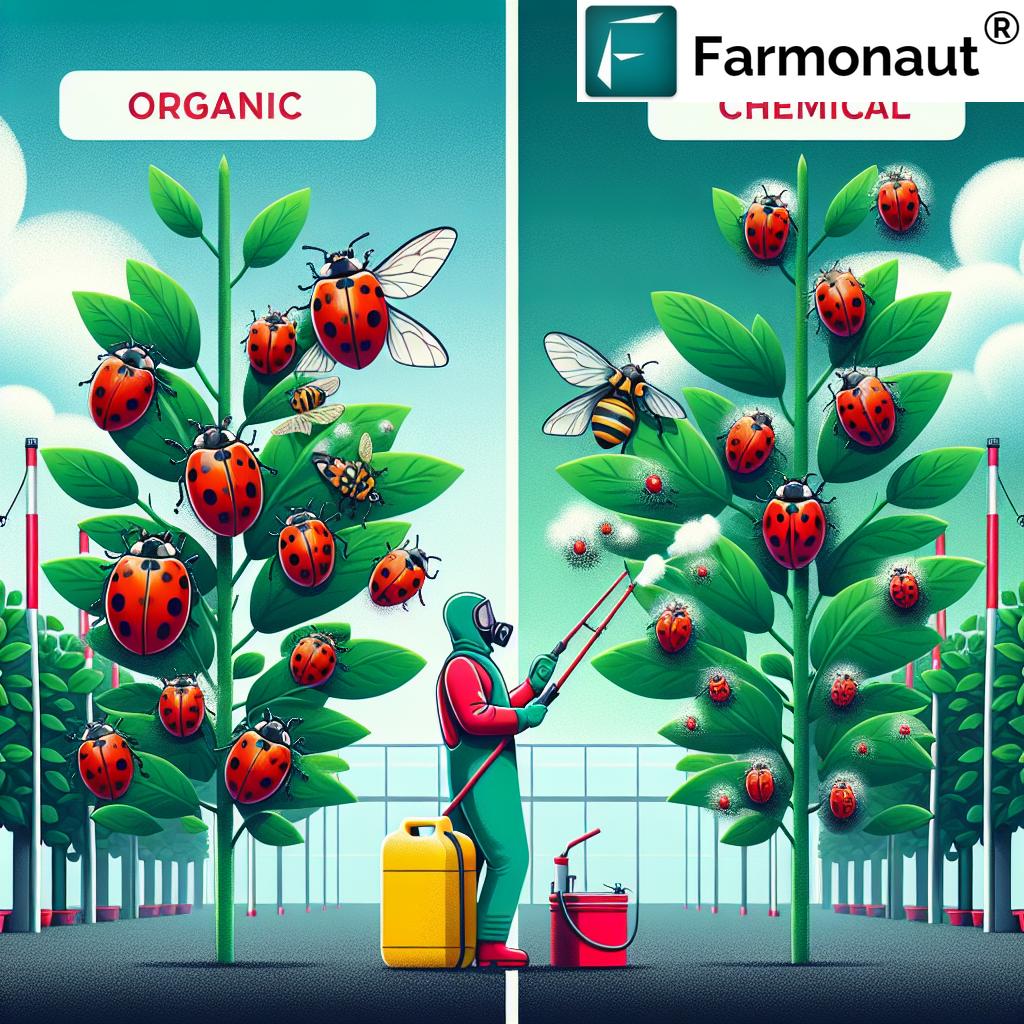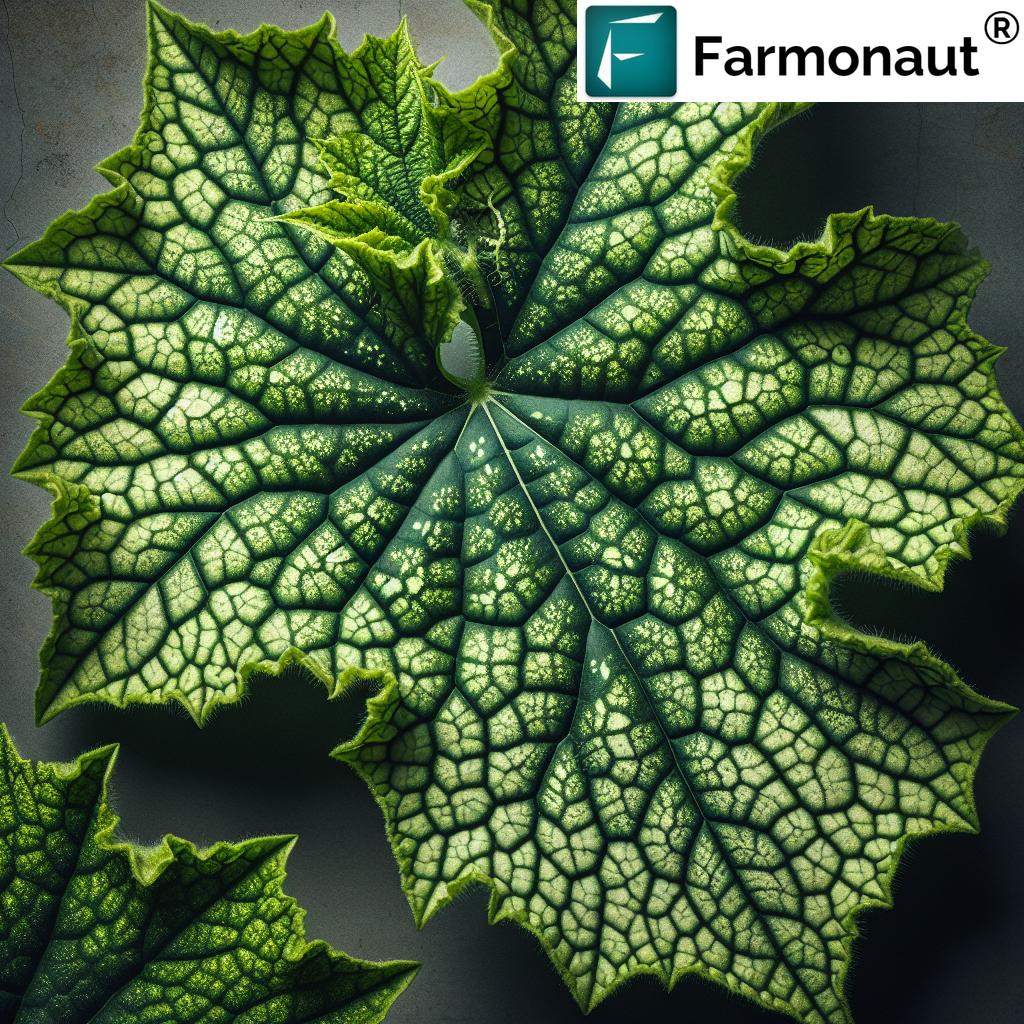Effective Mealybug Control: Organic and Chemical Treatments for Healthy Crops

As agricultural experts at Farmonaut, we understand the critical importance of protecting crops from pests and diseases. One of the most persistent and troublesome pests that farmers and gardeners face is the mealybug. These small, soft-bodied insects can cause significant damage to a wide variety of plants, from ornamentals to fruit-bearing crops. In this comprehensive guide, we’ll delve into the world of mealybugs, exploring their characteristics, the damage they cause, and most importantly, how to effectively control and manage these pests using both organic and chemical methods.
Understanding Mealybugs: Characteristics and Behavior
Mealybugs are small, soft-bodied insects that belong to the family Pseudococcidae. They are closely related to scale insects and are known for their distinctive white, waxy coating that covers their bodies. This waxy substance serves as a protective layer and gives them their characteristic “mealy” appearance.
Key Characteristics of Mealybugs:
- Size: Most mealybug species are small, ranging from 1-4 mm in length.
- Appearance: They have oval-shaped bodies covered in a white, powdery or waxy substance.
- Mobility: Adult females are typically sedentary, while males are winged but short-lived.
- Feeding Habits: Mealybugs are sap-sucking insects that feed on plant juices using their piercing-sucking mouthparts.
Mealybug Behavior and Life Cycle:
Understanding the life cycle and behavior of mealybugs is crucial for effective control. Here’s a breakdown of their typical life stages:
- Egg Stage: Females lay eggs in protective cottony sacs.
- Nymph Stage: Also known as crawlers, nymphs are mobile and actively seek feeding sites.
- Adult Stage: Females become sedentary and continue to feed and reproduce, while males develop wings but do not feed.
Mealybugs can complete their life cycle in about 30 days under optimal conditions, leading to rapid population growth if left unchecked.
Identifying Mealybug Infestations: Signs and Symptoms
Early detection of mealybug infestations is crucial for effective management. Here are the key signs and symptoms to look out for:
- White, Cottony Masses: The most obvious sign of mealybugs is the presence of white, cottony masses on plant surfaces, especially in protected areas like leaf axils, undersides of leaves, and along stems.
- Stunted Growth: Infested plants may show signs of stunted or distorted growth due to the mealybugs’ feeding activity.
- Yellowing Leaves: As mealybugs feed on plant sap, leaves may turn yellow and eventually drop prematurely.
- Honeydew and Sooty Mold: Mealybugs excrete a sticky substance called honeydew, which can lead to the growth of black sooty mold on plant surfaces.
- Presence of Ants: Ants are often attracted to the honeydew produced by mealybugs and may indicate an infestation.

Common Host Plants and Crops Affected by Mealybugs
Mealybugs are known to infest a wide range of plants, including both ornamental and agricultural crops. Some of the most commonly affected plants include:
- Citrus: Various citrus species are highly susceptible to mealybug infestations.
- Papaya: Mealybugs can cause significant damage to papaya plants, affecting both foliage and fruits.
- Grapevines: Vine mealybugs are a major pest in vineyards worldwide.
- Ornamental Plants: Many indoor and outdoor ornamental plants are susceptible, including orchids, ficus, and succulents.
- Fruit Trees: Various fruit trees, including apple, pear, and mango, can be affected.
- Vegetables: Some vegetable crops, such as tomatoes and peppers, may also be targeted by mealybugs.
The Impact of Mealybug Infestations on Crop Health and Yield
Mealybug infestations can have severe consequences for crop health and productivity. Some of the major impacts include:
- Reduced Plant Vigor: As mealybugs feed on plant sap, they deprive the plant of essential nutrients, leading to weakened growth and reduced overall vigor.
- Decreased Yield: Heavily infested plants often produce fewer and smaller fruits or flowers, significantly impacting crop yield.
- Quality Degradation: The presence of mealybugs and their excretions can render fruits and vegetables unmarketable due to cosmetic damage.
- Virus Transmission: Some mealybug species can act as vectors for plant viruses, further compromising plant health.
- Secondary Infections: The honeydew produced by mealybugs can lead to the growth of sooty mold, which can interfere with photosynthesis and further weaken the plant.
Organic Control Methods for Mealybug Management
At Farmonaut, we advocate for integrated pest management approaches that prioritize environmentally friendly solutions. Here are some effective organic control methods for managing mealybug infestations:
1. Physical Removal
For small infestations or in home gardens, physical removal can be an effective first line of defense:
- Use a cotton swab dipped in rubbing alcohol to directly remove visible mealybugs.
- Prune heavily infested plant parts and dispose of them properly.
- Use a strong stream of water to dislodge mealybugs from plant surfaces.
2. Horticultural Oils
Organic horticultural oils, such as neem oil or vegetable-based oils, can be effective against mealybugs:
- Apply a 2% solution of neem oil or other horticultural oil to affected plants.
- Ensure thorough coverage, especially on the undersides of leaves and in crevices where mealybugs hide.
- Repeat applications every 7-14 days as needed.
3. Insecticidal Soaps
Insecticidal soaps are another organic option that can effectively control mealybugs:
- Use a commercial insecticidal soap or make your own by mixing 1 tablespoon of liquid dish soap with 1 quart of water.
- Apply the solution directly to mealybugs, ensuring thorough coverage.
- Repeat applications every 7-10 days until the infestation is under control.
4. Beneficial Insects
Encouraging or introducing natural enemies of mealybugs can provide long-term, sustainable control:
- Ladybugs, lacewings, and parasitic wasps are effective predators of mealybugs.
- Create a favorable environment for these beneficial insects by avoiding broad-spectrum pesticides and providing diverse plantings.
- Consider purchasing and releasing beneficial insects in severely affected areas.
5. Diatomaceous Earth
This natural, powdery substance can be effective in controlling mealybugs:
- Apply food-grade diatomaceous earth to affected plant parts.
- The sharp edges of the diatomaceous earth particles can damage the waxy coating of mealybugs, leading to dehydration.
- Reapply after rain or heavy dew.
Chemical Control Options for Severe Mealybug Infestations
While we always recommend starting with organic methods, severe mealybug infestations may require the use of chemical insecticides. Here are some effective chemical control options:
1. Systemic Insecticides
Systemic insecticides are absorbed by the plant and distributed throughout its tissues:
- Imidacloprid and thiamethoxam are effective systemic insecticides against mealybugs.
- Apply as a soil drench or foliar spray according to label instructions.
- These provide long-lasting control but should be used judiciously to avoid impacts on beneficial insects.
2. Contact Insecticides
Contact insecticides kill mealybugs upon direct contact:
- Pyrethrin-based insecticides can provide quick knockdown of mealybug populations.
- Ensure thorough coverage of all plant surfaces for maximum effectiveness.
- Repeat applications may be necessary to control successive generations.
3. Insect Growth Regulators (IGRs)
IGRs interfere with the mealybug’s life cycle:
- Buprofezin and pyriproxyfen are effective IGRs for mealybug control.
- These products prevent mealybugs from completing their life cycle but may take longer to show visible results.
- IGRs are generally less harmful to beneficial insects compared to broad-spectrum insecticides.
4. Neonicotinoids
This class of insecticides can be effective against mealybugs but should be used with caution:
- Acetamiprid and dinotefuran are examples of neonicotinoids effective against mealybugs.
- These can be applied as foliar sprays or soil drenches.
- Use judiciously due to potential impacts on pollinators and beneficial insects.
Integrated Pest Management (IPM) Strategies for Mealybug Control
At Farmonaut, we strongly advocate for an Integrated Pest Management (IPM) approach to mealybug control. This comprehensive strategy combines various methods to achieve long-term, sustainable pest management:
1. Regular Monitoring
- Conduct regular inspections of plants, especially in areas prone to mealybug infestations.
- Use magnifying glasses or hand lenses to identify early signs of mealybug presence.
- Utilize Farmonaut’s satellite-based crop monitoring system for large-scale detection of potential infestations.
2. Cultural Control
- Maintain plant health through proper watering, fertilization, and pruning practices.
- Avoid over-fertilization with nitrogen, which can promote soft growth attractive to mealybugs.
- Practice good sanitation by removing plant debris and keeping the area around plants clean.
3. Biological Control
- Encourage natural predators by creating diverse plantings and avoiding broad-spectrum pesticides.
- Consider introducing beneficial insects like ladybugs, lacewings, or parasitic wasps.
- Use microbial insecticides containing entomopathogenic fungi like Beauveria bassiana.
4. Physical and Mechanical Control
- Use sticky traps to monitor and capture adult male mealybugs.
- Prune and destroy heavily infested plant parts.
- Use high-pressure water sprays to dislodge mealybugs from plants.
5. Chemical Control
- Use chemical insecticides as a last resort when other methods have failed.
- Choose selective insecticides that target mealybugs while minimizing harm to beneficial insects.
- Rotate between different classes of insecticides to prevent resistance development.
Preventing Mealybug Infestations: Best Practices
Prevention is always better than cure when it comes to pest management. Here are some best practices to help prevent mealybug infestations:
- Quarantine New Plants: Inspect and isolate new plants for at least two weeks before introducing them to your garden or greenhouse.
- Maintain Plant Health: Healthy plants are more resistant to pest infestations. Ensure proper watering, fertilization, and pruning practices.
- Avoid Overcrowding: Proper spacing between plants improves air circulation and makes it harder for mealybugs to spread.
- Regular Inspections: Conduct routine checks of your plants, paying close attention to hidden areas where mealybugs tend to congregate.
- Control Ant Populations: Ants often protect and transport mealybugs. Managing ant populations can indirectly help control mealybugs.
- Use Preventive Treatments: Consider applying preventive treatments like neem oil or insecticidal soaps during periods of high risk.
The Role of Technology in Mealybug Detection and Management
At Farmonaut, we leverage cutting-edge technology to enhance pest detection and management strategies. Our satellite-based crop monitoring system plays a crucial role in early detection and management of mealybug infestations:
- Early Detection: Our satellite imagery can detect subtle changes in plant health that may indicate the early stages of a mealybug infestation.
- Large-Scale Monitoring: Farmonaut’s technology allows for efficient monitoring of large agricultural areas, enabling timely interventions.
- Data-Driven Decision Making: By providing real-time data on crop health, our system helps farmers make informed decisions about pest management strategies.
- Precision Agriculture: Our technology enables targeted applications of pest control measures, reducing unnecessary pesticide use and promoting sustainable farming practices.
To learn more about how Farmonaut’s technology can help in mealybug management, visit our app page or explore our API documentation.
Comparison: Traditional Mealybug Detection vs. Farmonaut Satellite System
| Aspect | Traditional Detection | Farmonaut Satellite System |
|---|---|---|
| Detection Speed | Slow, relies on visual inspections | Fast, uses satellite imagery for rapid detection |
| Accuracy | Variable, depends on inspector’s expertise | High, uses AI and multispectral analysis |
| Coverage Area | Limited to physically accessible areas | Covers large areas efficiently |
| Cost-effectiveness | Labor-intensive and time-consuming | Highly cost-effective for large-scale monitoring |
| Early Detection Capability | May miss early signs of infestation | Can detect subtle changes indicating early infestations |
Case Studies: Successful Mealybug Management in Different Crops
While we don’t include specific case studies or success stories, we can discuss general scenarios where effective mealybug management has been achieved in various crops:
Citrus Orchards
In many citrus-growing regions, integrated pest management strategies have successfully controlled mealybug populations. These typically involve:
- Regular monitoring using pheromone traps and visual inspections
- Targeted applications of horticultural oils during dormant seasons
- Release of beneficial insects like parasitic wasps
- Selective use of systemic insecticides when necessary
Vineyards
Vine mealybug management in vineyards often includes:
- Mating disruption techniques using pheromones
- Careful timing of insecticide applications to target crawler stages
- Trunk wrapping to prevent mealybugs from moving up the vines
- Encouraging natural predators through habitat management
Greenhouse Crops
In controlled environments like greenhouses, successful mealybug management often involves:
- Strict quarantine procedures for new plant material
- Regular releases of beneficial insects
- Use of sticky traps for monitoring and control
- Targeted spot treatments with insecticidal soaps or neem oil
Future Trends in Mealybug Control
As we look to the future, several promising trends are emerging in the field of mealybug control:
- Advanced Biological Control: Research into new species of natural enemies and improved methods for their mass production and release.
- Biopesticides: Development of new, environmentally friendly biopesticides derived from natural sources.
- Gene Editing: Potential use of CRISPR and other gene-editing technologies to develop pest-resistant crop varieties.
- Precision Agriculture: Continued advancements in satellite and drone technology for early pest detection and targeted treatments.
- AI and Machine Learning: Improved algorithms for pest identification and prediction of outbreak patterns.
Frequently Asked Questions (FAQs)
Q1: How do I know if my plants have mealybugs?
A1: Look for white, cottony masses on plant surfaces, especially in protected areas like leaf axils and stem joints. You may also notice sticky honeydew or black sooty mold on leaves.
Q2: Can mealybugs kill my plants?
A2: While a small number of mealybugs may not kill a plant, severe infestations can lead to plant death by weakening the plant through excessive sap feeding and transmitting plant viruses.
Q3: Are mealybugs harmful to humans?
A3: Mealybugs are not directly harmful to humans. However, they can cause significant damage to plants and crops, indirectly affecting human food sources and ornamental plants.
Q4: How quickly do mealybugs spread?
A4: Mealybugs can spread quickly, especially in favorable conditions. A female can lay hundreds of eggs, and the crawlers (nymphs) can move to new plants, leading to rapid infestation spread.
Q5: Can I use dish soap to kill mealybugs?
A5: Yes, a solution of mild dish soap and water can be effective against mealybugs. Mix 1 tablespoon of dish soap with 1 quart of water and spray directly on the insects.
Q6: How often should I treat my plants for mealybugs?
A6: For active infestations, treat every 7-10 days until the problem is under control. For prevention, monthly treatments during growing seasons can be beneficial.
Q7: Are there any plants that repel mealybugs?
A7: While no plants completely repel mealybugs, some plants like marigolds, nasturtiums, and alliums are less attractive to these pests and can be used as companion plants.
Q8: How can Farmonaut’s technology help in mealybug management?
A8: Farmonaut’s satellite-based crop monitoring system can detect early signs of plant stress caused by mealybug infestations, allowing for timely interventions across large agricultural areas.
Q9: Are organic methods as effective as chemical treatments for mealybug control?
A9: Organic methods can be very effective, especially when used as part of an integrated pest management strategy. While they may work more slowly than chemical treatments, they are often safer for beneficial insects and the environment.
Q10: How long does it take to get rid of a mealybug infestation?
A10: The time to control a mealybug infestation can vary depending on the severity and the methods used. With consistent treatment, significant improvement can often be seen within 2-4 weeks, but complete eradication may take longer.
Conclusion
Effective mealybug control requires a comprehensive approach that combines vigilant monitoring, preventive measures, and a range of treatment options. By understanding the biology and behavior of mealybugs, farmers and gardeners can implement targeted strategies to protect their crops and plants from these persistent pests.
At Farmonaut, we’re committed to providing innovative solutions that enhance pest management practices. Our satellite-based crop monitoring system offers a powerful tool for early detection and targeted intervention, complementing traditional pest management strategies.
By integrating advanced technology with time-tested organic and chemical control methods, we can achieve more sustainable and effective mealybug management. This not only protects crop yields and quality but also promotes more environmentally friendly farming practices.
Remember, successful pest management is an ongoing process that requires patience, persistence, and adaptability. Stay informed about the latest developments in pest control, and don’t hesitate to seek professional advice when dealing with severe infestations.
For more information on how Farmonaut can assist you in your pest management efforts, visit our website or download our app:
Together, we can work towards healthier crops and more sustainable agriculture.









